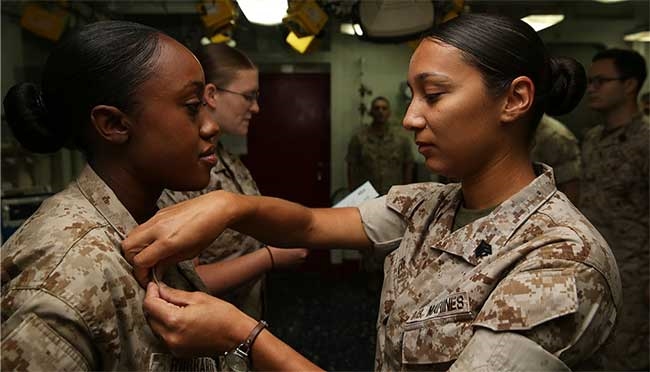
Happy Women’s History Month! The contributions of women in the services are phenomenal. Below are six things that you may not have known about women in the military.
1. Women in the War on Terror
Today’s military is much more integrated along gender lines than at any time in the past. Combat missions no longer exclude women. They are pilots and vehicle drivers and mechanics and infantry officers. But while the U.S. military today has never had a higher fraction of women; they remain just 16 percent of the total force. Percentages have roughly doubled in the last generation for the various services. But, even today, averaged across the four major Department of Defense services; women represent only one of every six Americans in uniform. Ranging from about 8 percent in the Marine Corps to 19 percent in the Air Force.
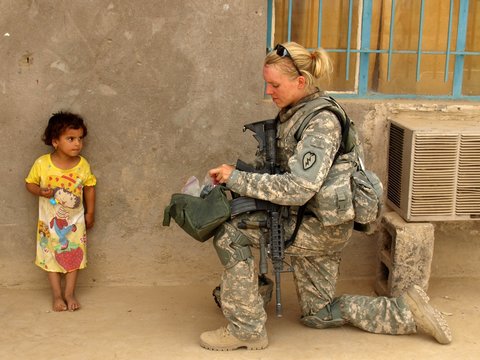
In approximately 10 years of combat operations in Iraq and Afghanistan, over 283,000 female members deployed. Over 800 have been wounded and over 130 have died. According to the Department of Defense (DoD), as of February 29, 2012; over 20,000 female members have or are serving in Afghanistan and Iraq. U.S. forces were out of Iraq as of Dec. 2011. On numerous occasions, heroism and two Silver Star medals recognized the contributions of women. This outcome has resulted in a renewed interest in Congress, the Administration; and beyond in reviewing and possibly refining or redefining the role of women in the military.
2. Removal of Combat Exclusion Law
Until 1993, 67 percent of the positions in the Army were open to women. In 2013, 15.6 percent of the Army’s 1.1 million soldiers, including National Guard And Reserve, were female; serving in 95 percent of occupations.As of 2017, 78 percent of the positions in the Army are open to women. In the U.S. Air Force, in 2015, 99% of career fields are open to women. The only exceptions are: Special Tactics Officer; Combat Control; Special Operations Weather Technician; Combat Rescue Officer; Pararescue and Tactical Air Control Party.
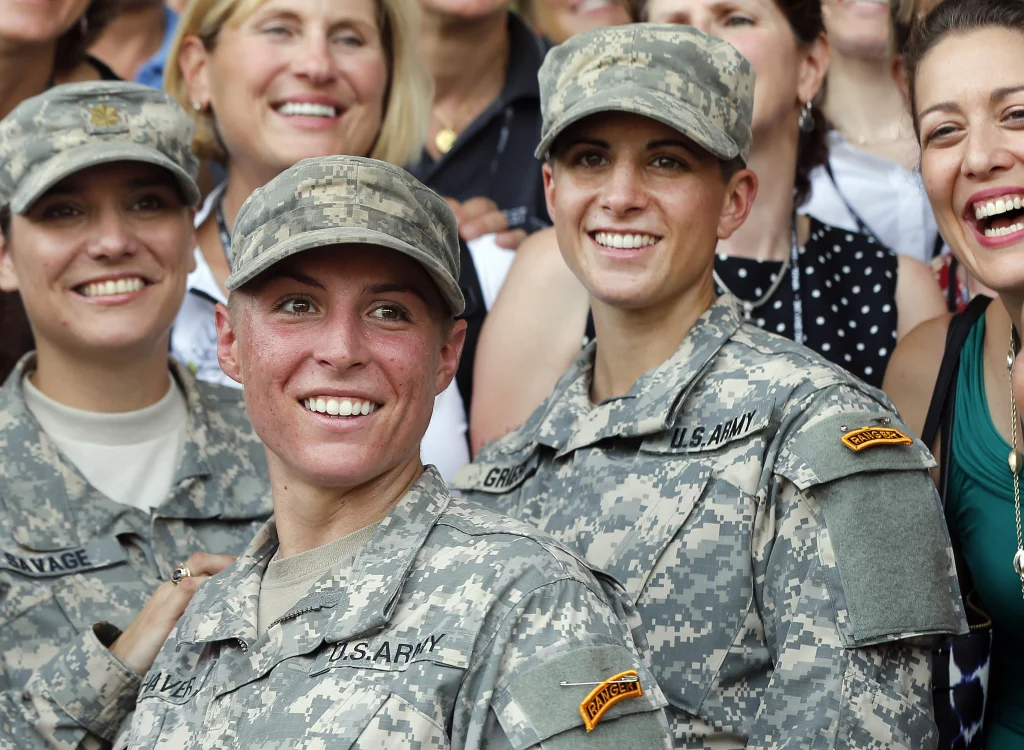
In January 2013, the US ended the policy of “no women in units tasked with direct combat”. Also in 2013, female US Army soldiers enrolled in a training course designed by Combined Joint Task Force Paladin. Specifically designed for Female Engagement Team members. The course intended to train female soldiers for tasks such as unexploded ordnance awareness; biometrics; forensics; evidence collection; tactical questioning; vehicle and personnel searches and homemade explosive devices.
Women in Combat Roles
By May 2015, none of the nineteen women vying to become the first female Army Rangers had passed Ranger School. Eleven of the nineteen dropped out in the first four days. Of the remaining eight ,who failed in the next step, three received the option to restart from the beginning. Two graduated in August 2015. A third graduated in October 2015.
In April 2015, after two-and-a-half-year period in which the Marine Corps’ Infantry Officer Course became gender-integrated for research; ended without a single female graduate. The final two participants failed the initial Combat Endurance Test. In 2016, Secretary of Defense Ash Carter opened all military occupations to women, without exception. This opened up the roughly 10% of all military jobs that had previously closed to women. This included positions in infantry, armor, reconnaissance, and some special operations units.
Heroism
Women have been injured, killed, and awarded high honors. Two women received the Silver Star. Sergeant Leigh Ann Hester in 2005 and Army Specialist Monica Lin Brown in 2007 for their actions in combat.
Actions in Combat
Sergeant First Class Hester is one of the few women awarded for valor in close-quarters combat. Leigh Ann Hester was a sergeant with the National Guard’s Kentucky-based 617th Military Police Company. She deployed to Iraq. In 2005, she was scanning and clearing a route for a supply convoy near Baghdad. Her squad was ambushed by enemy fire.
She was trained for this, as it was a risk that came with her daily job in Iraq. Thus, when they became under attack, she knew exactly what to do. She directed her team away from the enemy’s intense fire and into a flanking position. This exposed multiple irrigation ditches and an orchard that the enemies were using to stage the attack.
Actions Under Fire
She was initially directing fire, then began fighting on foot. Sgt. Hester displayed incredible bravery as she had walked directly into the line of fire; to kill at least three enemy combatants at close range. This resulted in numerous convoy members lives saved. With thirty-three insurgents killed or wounded and one captured, every member of her unit survived. Her heroic actions led her to become the first woman since World War II to earn the Silver Star Medal. She was also the very first to ever earn it for combat valor.
Sergeant Monica Lin Brown
Monica Lin Brown was born on May 24, 1988 in Lake Jackson, Texas. She joined the United States Army at the age of 17. She became a Combat Medic and has risen to the rank of Sergeant. On April 25, 2007, Brown was serving as a Combat Medic with the 4th Squadron; 73d Cavalry Regiment; 4th Brigade Combat Team; 82nd Airborne Division in Afghanistan. Brown was on a combat patrol when one of the vehicles in her convoy struck a pressure plate IED. It engulfed the vehicle in an intense fireball. The convoy was ambushed and began taking fire. Brown moved on foot to evaluate the casualties. After assessing the injuries, she moved them to a safer position.
Courage Under Fire
The enemy fighters began engaging the patrol with mortar rounds. Brown then used her own body to shield the casualties from large chunks of shrapnel. The platoon sergeant used the ANA Ranger to move the wounded and Brown to a safer position. Not soon after did a large mortar explosion send shrapnel flying in the location Brown had been treating the casualties. Once moved, it wasn’t long until their new position came under small arms fire. However, Brown did not stop treating the wounded and protected them using her own body as a shield. She made sure to help her fellow soldiers, stabilize, and prepare them for MEDEVAC.
The patrol leader found it incredible she was still alive; and treating the casualties amidst the extremely dangerous conditions she was operating under. Despite her heroic actions, Brown didn’t want to leave. But she was pulled from the field. Only days later because her presence had attracted attention and there were many issues regarding women in combat roles.
Recognition
For her actions, Brown was awarded the Silver Star, the United States military’s third-highest medal for valor in combat. Brown became the first woman during the War in Afghanistan; and only the second woman since World War II to receive the Silver Star. She was presented with the Silver Star by Vice President Dick Cheney in a ceremony on March 21, 2008.
Over 10,000 combat action badges were awarded to women who served in combat in Iraq and Afghanistan. On February 2023, a series of new policies were published; by the US Defense Department in order to support military members. Anyone who receives an abortion could travel out of state and three weeks of administrative leave.
3. A First for the Marine Corps
Lorna Mahlock will create history, becoming the first Black woman to serve as a two-star general in the service. United States President Joe Biden appointed Brigadier General Mahlock to the rank of major general. The Pentagon announced on December 6, and the Senate confirmed her. Mahlock is the deputy director of cybersecurity for combat support at the National Security Agency at Fort Meade, Maryland. Born in Kingston, Jamaica, Mahlock immigrated to Brooklyn, New York; at the age of 17 in 1985, according to a biography written by Marquette University. She enlisted in the Marine Corps three months later and became an air traffic controller.
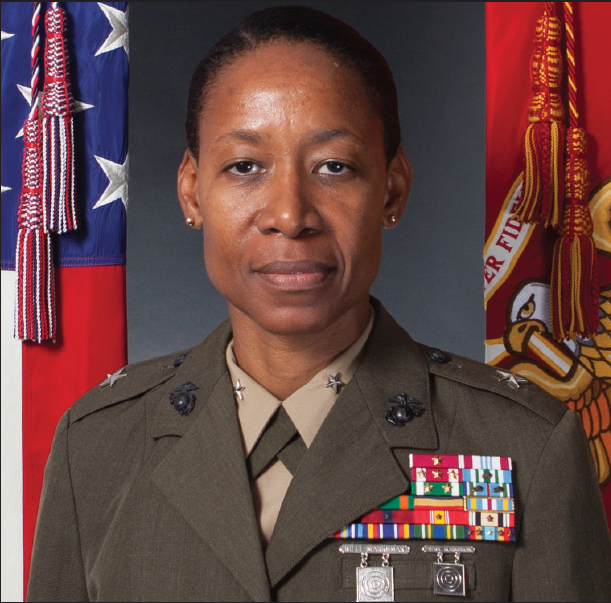
Humble Beginnings
According to a biography by the Women Marines Association; Mahlock received her commission through the Marine Corps Enlisted Commissioning Education Program; in December 1991 after graduating from Marquette. She has amassed multiple higher degrees. Including two master’s degrees in Strategic Studies from the US Army War College and the Naval Postgraduate School. Lorna Mahlock was nominated to the grade of brigadier general in 2018. She became the first Black woman to achieve that rank. She has since served as the Marine Corps’ chief information officer and director of command, control, communications, and computers.
The Few and Proud
One of the smallest military branches; the Marine Corps has the lowest percentage of women among its troops at nine percent. Only three women in the Corps’ history have picked up the rank of lieutenant general. All of them are retired. General Michael Langley, now head of US Africa Command, in August became the first Black Marine four-star general.
4. Navy Super Bowl Herstory
About 113 million people around the world watched Super Bowl LVII. Which means that nearly that many saw the Navy flyover and presentation of the flags by the U.S. Armed Forces Color Guard during the national anthem. This year, the flyover celebrated 50 years of women in naval aviation; by having an all-female team fly in formation over the stadium in an F-35C Lightning II; two FA-18F Super Hornets and an EA-18G Growler.
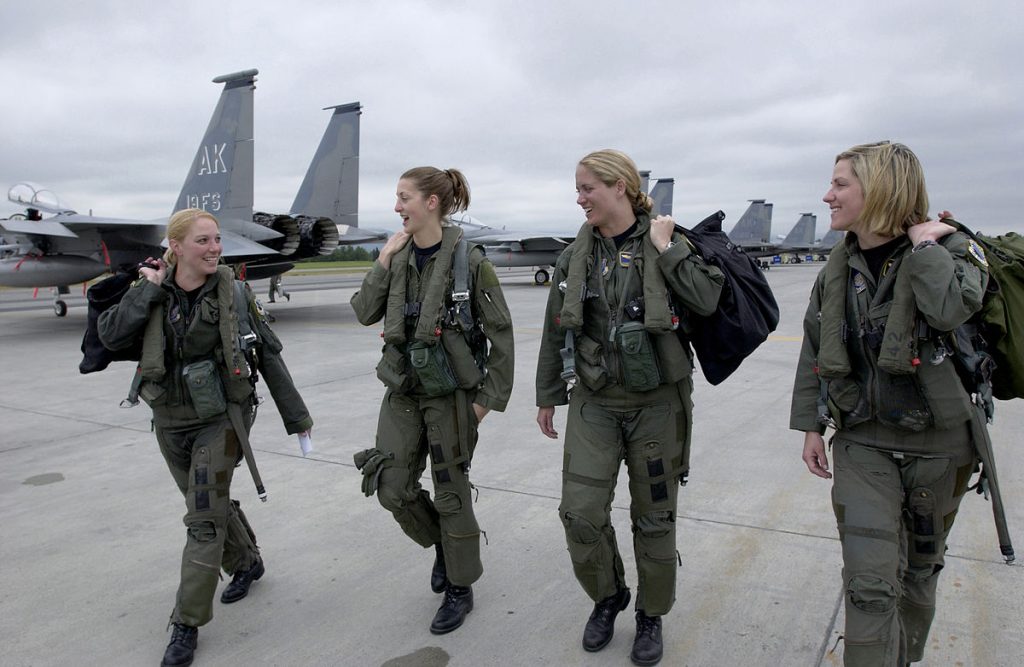
Ngalle and Dente, two of the 11 pilots chosen for the mission. Seven flew during the game, while four others served as alternates. Before the big day, though, the aviators spent the week at Luke Air Force Base. They meet with their Air Force partners, the Air Force community and civilian leaders for a pre-Super Bowl celebration. Students from local schools also got to check out the aircraft; talk with pilots and aircrew and even meet with some NFL Hall of Famers.
Other headliners
Some lucky folks, including Arizona Gov. Katie Hobbs, even got to ride in an F/A-18E Super Hornet. Navy Lt. Cmdr. Calli Zimmerman took Hobbs up for about an hour, doing basic maneuvers such as barrel rolls and wingovers. Zimmerman said she almost got up to five G-forces. Other history makers were also on hand for the weeklong festivities, including Navy Capt. Joellen Oslund. After entering naval flight training in 1972, she became the service’s first female helicopter pilot.
5. Women in Submarines
On 29 April 2010, the Department of the Navy announced authorization of a policy change allowing women to begin serving on board navy submarines. The new policy and plan began with the integration of female Officers. A group of up to 24 female Officers; three Officers on each of eight different crews; scheduled to enter the standard nuclear submarine training pipeline in July 2010. They expected to report to submarine duty by late 2011 or early 2012.

Integration of Enlisted females into submarine crews was expected to begin soon thereafter. Initial candidates for female Submarine Officer positions were highly qualified selects from accession sources. This included the Naval Academy, Naval Reserve Officers Training Corps, STA-21 program and Officer Candidate School; with transfers possible for those from other Unrestricted Line Officer communities. A group of up to eight female Supply Corps Officers was also expected to complete requisite training; and begin submarine service in the same time frame.
Initial Assignments
Initial assignments for female submariners were on the blue and gold crews of selected guided-missile submarines (SSGNs) and ballistic-missile submarines (SSBNs). Two submarines of each type served as the inaugural vessels. The first group of U.S. female submariners completed nuclear power school. They officially reported on board two ballistic and two guided missile submarines in November 2011. In 2012, it was announced that 2013 would be the first year for women to serve on U.S. attack submarines. On 22 June 2012, a sailor assigned to USS Ohio (SSGN-726) became the first female supply officer to qualify in U.S. submarines. Lt. Britta Christianson of Ohio‘s Gold Crew received her Submarine Supply Corps “dolphins” from the Gold Crew Commanding Officer Capt. Rodney Mills during a brief ceremony at Puget Sound Naval Shipyard and Intermediate Maintenance Facility (PSNS & IMF).
Unrestricted Line Officer Success
On 5 December 2012, three sailors assigned to USS Maine (SSBN-741) and USS Wyoming (SSBN-742); became the first female unrestricted line officers to qualify in U.S. submarines.LTJG Jennifer Noonan [ROTC Cornell University], a native of Scituate MA, and LTJG Amber Cowan both of Maine‘s Blue Crew, and LTJG Marquette Leveque, a native of Fort Collins, Colo., assigned to the Gold Crew of Wyoming, and received their submarine “dolphins” during separate ceremonies at Naval Base Kitsap-Bangor, Wash. and Naval Submarine Base Kings Bay, Ga. respectively. In 2013, Navy Secretary Ray Mabus said that the first women to join Virginia-class attack subs had been chosen. They were newly commissioned female officers scheduled to report to their subs in fiscal year 2015. In August 2016, Chief Petty Officer Dominique Saavedra became the first enlisted female sailor to earn her submarine qualification; and assigned to USS Michigan (SSGN-727).
6. Women at Service Academies
It literally took an act of Congress to open the United States Military Academies to women. In 1975, then President Ford, signed Public Law 94-106. It required the services to open the hallowed halls of West Point, Annapolis, and the Air Force Academy to women. In the fall of 1976 female cadets began their education and military orientation; as the “Class of ’80” became the first coed class. When those first classes graduated in 1980 of the 327 women who began, 217 graduated – a whopping 66%.
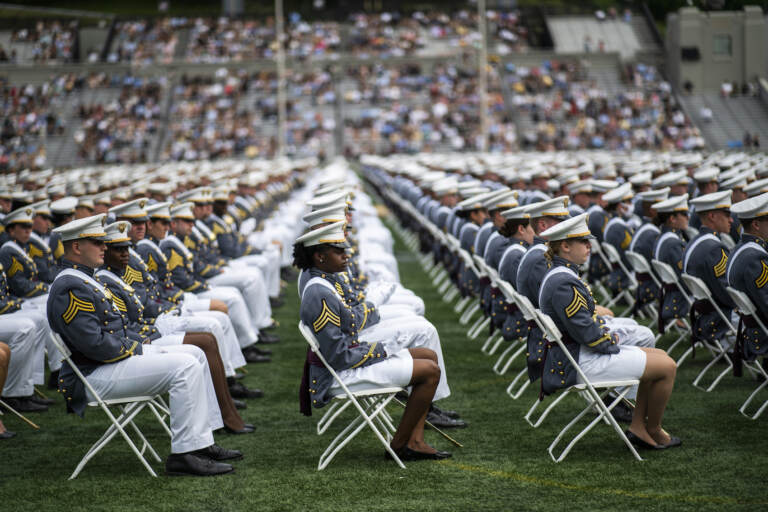
The transition wasn’t easy. The lingering male chauvinist attitude didn’t help matters but for the most part; women cadets succeeded in ignoring the micro-minded while acing the academics. Academic failure was twice as high for the men. Women met challenges, and showed they were capable of handling the rigorous physical and military courses. Respect for the abilities of women slowly emerged within the academies. Surprisingly the hallowed halls remained intact. They were not painted pink or adorned with Martha Stewart decor.
The First of First Captains
In 1989, Kristin M. Baker, Class of 1990, became the first female cadet named Brigade Commander. She was the first woman to command the West Point Corps of Cadets. Graduation rates at West Point are nearly equal for males and females–79 percent and 75 percent, respectively. Today the young women who graduate from our military academies enter the respective services with pride in their accomplishment. Just as do the young men. They don’t want to be treated separately, or as unique . Women simply want to do their job.
Military Women’s Memorial
Dedicated to the more than 3 million women who have served our country since the American Revolution; the Military Women’s Memorial is located at the gateway to Arlington National Cemetery. It is the nation’s only major national memorial to honor all women who have defended the nation. From the Revolution to the present. Opened to the public in 1997, the Memorial’s award-winning design was accomplished by the architectural firm of Weiss/Manfredi. It incorporates as its facade the historic Hemicycle. A retaining wall dedicated in 1932 as part of the Memorial Bridge project. Originally intended as the ceremonial entrance to Arlington National Cemetery. Our Memorial is located on the western terminus of Memorial Drive. It is situated on the historic line connecting the Lincoln Memorial and Arlington House.
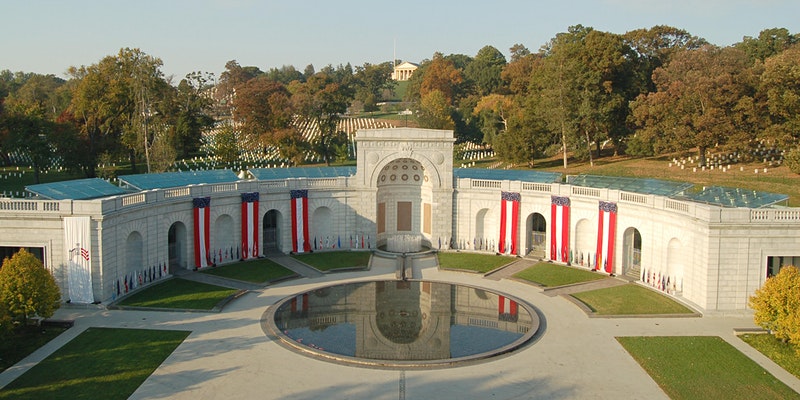
“What About Us?”
In 1983, after the dedication of the Vietnam Veterans Memorial; World War II women veterans said that it was about time to honor them. “What about us? We served, too.” They approached former Ohio Rep. Mary Rose Oakar; and conducted research. The issue found was that women were almost never included when the nation honored its veterans. The American Veterans Committee (AVC), a national group of veterans whose origins date back to 1944; also discussed the lack of tribute to military women. When they learned that Congresswoman Oakar was holding hearings for a national women veterans memorial; they volunteered to contact veterans groups, the Departments of Defense and Veterans Affairs, and to lobby Congress
In 1985, they incorporated the Women In Military Service For America Memorial Foundation (WIMSA). Resolutions and testimony followed, and on November 6, 1986, President Ronald Reagan signed into law PL-610. This bill authorized the establishment of “a memorial on Federal lands in the District of Columbia; and its environs to honor women who have served in the Armed Forces of the United States”. The law also charged WIMSA with conducting the public campaign on behalf of the Memorial.
Site Selection
Site selection was the next step. They selected Arlington National Cemetery’s original main gate structure, due to its granite retaining wall. The prestigious architectural firm; McKim, Mead, and White, created the original structure design; by as part of the Memorial Bridge project. President Herbert Hoover dedicated it in 1932 but never finished. This amazing architectural feature sat idle for 54 years until designated for the Foundation.
In 1989, a two-stage national design competition was held. A panel of women veterans and distinguished architects and designers judged more than 130 designs; with basic criteria for consideration prescribed by the National Capital Memorial Advisory Commission. In November 1989, the Foundation announced the winner. A team led by New York architects Marion Weiss and Michael Manfredi; whose mother was a World War II Army nurse.
The Design
The Weiss/Manfredi design originally included tall glass spires; rising from the original semicircular retaining wall’s upper terrace and which would glow softly in the night. The design was ultimately altered. Because of concerns that the illuminated spires would have too great an impact; on the historic memorial corridor and did not blend harmoniously with the neoclassical architecture of the existing structure. They went back to the drawing board and returned with an arc of glass tablets; etched with quotations by and about military women; which would act as skylights running the entire length of the exhibit gallery. As the sun passed overhead, the quotations were to reflect down onto the gallery walls inside the Memorial.
Construction began in June 1995; after a groundbreaking ceremony. The completed Memorial—dedicated and opened to the public on October 18, 1997. It includes the Court of Valor with its reflecting pool and a 200-jet fountain representing the sound of women’s voices. The upper terrace features stunning views of the Washington Monument and Arlington National Cemetery; as well as the Memorial’s signature arc of glass tablets.
The Heart of the Memorial is the Register. However, visitors are offered a unique look at some of the individual stories that make up the collective history of women’s service. Tributes can be made to a specific woman who has served. Visitors can access an interactive computer database. It holds the names, service data, memorable experiences, awards and decorations; and photographs of more than 300,000 servicewomen registered with the Memorial. While substantial and likely the largest related to military women in the world; this number represents less than 10 percent of the approximately 3 million women who have served since the American Revolution.
